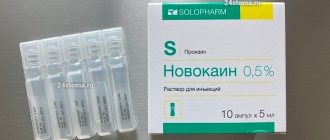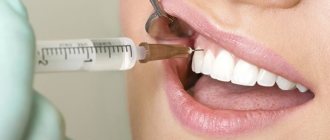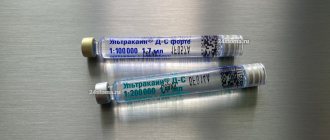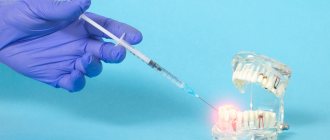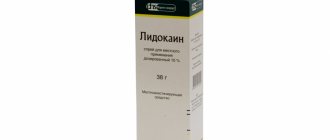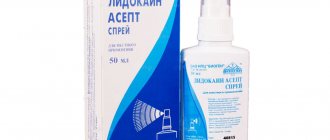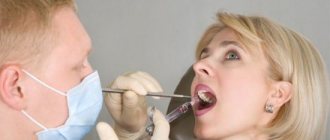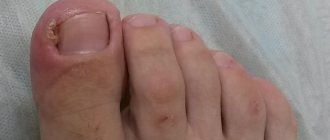Lidocaine is an effective pain reliever. Local anesthetics inhibit the ionic currents involved in the formation of the irritant, due to which the analgesic effect is achieved. Lidocaine stabilizes neuronal membranes, suppresses nerve conduction, and reduces the degree of depolarization.
Compound
The solution for intravenous administration includes the active component lidocaine hydrochloride (monohydrate form).
An additional component is water for injection. The active component included in the injection solution is also lidocaine hydrochloride (monohydrate form), additional components are sodium chloride, water.
Spray 10% for topical use contains lidocaine , as well as additional components: propylene glycol, peppermint oil, 96% ethanol.
Eye drops contain lidocaine hydrochloride , as well as benzethonium chloride, sodium chloride, and water.
The gel for external use also contains a similar active substance.
Storage conditions
Medicines containing lidocaine are included in list B. This means that the drug does not have to be in the refrigerator.
The active substance retains all its physicochemical and pharmacological properties for the entire shelf life.
Compliance with conditions for quality storage:
- Temperature range from 10 to 25°C
- Humidity indicator is not higher than 70%
- Avoid exposure to direct sunlight.
Medicines used for anesthesia should absolutely not be frozen, otherwise they will lose most of their properties. They should be placed inside a special first aid kit or in a closed cabinet.
Lidocaine release form
The product is available in different forms:
- The solution, which is administered intravenously, is colorless and odorless. The solution is poured into ampoules of 2 ml, 5 pcs. in blister strip packaging. Two such packages are placed in a cardboard pack.
- The solution intended for injection is odorless and colorless, it is bottled in ampoules of 2 ml, in blister packs - 5 such ampoules. A solution of 10%, 2%, 1% is available.
- Spray with lidocaine 10 percent is a colorless alcohol solution that has a menthol aroma. Contained in bottles (650 doses), it is equipped with a special pump and spray nozzle. The bottle is placed in a cardboard box.
- Eye drops 2% are colorless and odorless, but sometimes they may be slightly colored. Contained in 5 ml polyethylene bottles.
- A gel is also available.
pharmachologic effect
Lidocaine - what is it?
Wikipedia indicates that lidocaine is a derivative of acetanilide in chemical structure. It has a pronounced antiarrhythmic and local anesthetic effect.
The pharmacological group to which the active substance belongs is local anesthetics .
Inhibits nerve conduction by blocking sodium channels in nerve fibers and nerve endings, thereby providing a local anesthetic effect.
If we compare the anesthetic effect of procaine , then lidocaine is 2-6 times superior to it. Also, its effects develop faster and last longer. How long the drug lasts depends on the interaction with other drugs. If the drug is used simultaneously with Epinephrine , then the effect lasts more than 2 hours. When applied topically, vasodilation is observed, but no local irritating effect is noted.
In the body, it stabilizes the cell membrane, blocks sodium channels, increases the level of membrane permeability for potassium ions, which determines its antiarrhythmic effect .
Under its influence, repolarization in the ventricles is accelerated, the fourth phase of depolarization in Purkinje fibers is inhibited, without affecting the electrophysiological state of the atria.
It does not have a significant effect on myocardial contractility and conductivity. The negative inotropic effect is slightly pronounced, it manifests itself for a short time and only if the drug is administered in large doses.
Storage in medical institutions and pharmacies
| Medical institution | Storage organization |
| Pharmacy warehouse | Ventilated shelves. The air temperature is not higher than 25°C. |
| Pharmacy | Closed pull-out shelves or cabinet; The air temperature is not higher than 25°C. |
| Hospital, dentistry | Closed container in the closet; The air temperature is not higher than 25°C. |
Note: If the air temperature exceeds 25°C, then it is allowed to place the local anesthetic in a refrigerator with a temperature reading of 12°C .
Pharmacokinetics and pharmacodynamics
The highest concentration in the blood after intravenous administration is observed after 5-15 minutes, if the infusion is carried out slowly without a saturating initial dose, the maximum concentration is observed after 5-6 hours, and in people with acute myocardial infarction it can be achieved after a long time - up to 10 hours. Binds to plasma proteins by 50-80%. It is quickly distributed in the body and penetrates the placental and blood-brain barriers.
Metabolism mainly occurs in the liver; microsomal enzymes , resulting in the formation of active metabolites - glycine xylidide and monoethylglycine xylidide . People with liver disease have a slower metabolism. Excretion occurs in bile and urine.
If lidocaine cream or other agents are applied topically, absorption depends on the dose and also on the site where the lidocaine cream or gel is applied. Absorption is affected by the rate of perfusion in the mucosa.
There is good absorption in the respiratory tract, so care must be taken to prevent the administration of the drug in toxic doses.
After injections of lidocaine intramuscularly, almost complete absorption is noted. It is distributed quickly and binds to proteins, depending on the concentration of the active ingredient, by 60-80%.
The half-life depends on the dose administered, it is 1-2 hours.
If an aerosol is used, its effect appears within 1 minute and lasts 1-2 minutes. There is a gradual disappearance of the achieved decrease in sensitivity over 15 minutes.
Lidocaine gel –
There are both professional lidocaine-based gels for dental clinics and those that can be bought at any pharmacy. An example of a common gel with lidocaine is the drug “Kamistad”. This gel contains lidocaine and chamomile extract as active ingredients. Created specifically for application to the oral mucosa. It has an analgesic and slight anti-inflammatory effect.
Lidocaine gel: price The cost of the drug Kamistad is about 230 rubles. If we talk about analogues for anesthesia of the mucous membrane, then the Cholisal gel has a slightly less pronounced, but longer-lasting analgesic effect. The latter also has a pronounced anti-inflammatory effect. The cost of the last drug is about 300 rubles.
Indications for use
A number of indications for the use of different forms of the drug are determined.
Indications for use intravenously and intramuscularly:
- for carrying out infiltration, spinal, epidural, conduction anesthesia ;
- for terminal anesthesia (also used in ophthalmology);
- for ventricular arrhythmias that are associated with glycoside intoxication;
- for the relief and prevention of the development of repeated ventricular fibrillation in patients with acute coronary syndrome, as well as repeated paroxysms of ventricular tachycardia .
In dentistry, Lidocaine in ampoules is used for local anesthesia during surgical interventions in the oral cavity:
- when removing baby teeth;
- when opening superficial abscesses ;
- when removing bone fragments and suturing wounds;
- for anesthesia of the gums for the purpose of fixing a prosthesis or crown;
- in order to suppress or reduce the enhanced pharyngeal reflex during preparation for an x-ray examination;
- before removal or excision of an enlarged papilla of the tongue;
- before excision of benign superficial mucosal tumors;
- for opening salivary gland cysts and frenulectomy in children.
Application in ENT practice:
- before septectomy , electrocoagulation , resection of nasal polyps;
- for additional pain relief before opening a peritonsillar abscess ;
- as additional anesthesia before puncture of the maxillary sinus ;
- before tonsillectomy for the purpose of pain relief and reduction of the pharyngeal reflex (not used for adenectomy and tonsillectomy in children under eight years of age);
- for pain relief before washing the sinuses.
Use for examinations and endoscopy:
- for anesthesia, if necessary, insert a probe through the mouth or nose;
- for anesthesia before performing rectoscopy and if necessary, replacing catheters.
Application in obstetrics and gynecology:
- for the purpose of anesthetizing the perineum for episiotomy or treatment;
- for anesthesia of the surgical field during a number of surgical interventions;
- for anesthesia when suturing in case of abscesses ;
- for pain relief during excision and treatment of hymen rupture.
Application in dermatology:
- for anesthesia of mucous membranes before minor surgical operations.
Application in ophthalmology:
- for anesthesia, if necessary, use contact research methods;
- for pain relief during short-term interventions on the conjunctiva and cornea;
- during preparation for ophthalmological operations.
When is lidocaine indicated?
The range of indications for Lidocaine solution includes the following conditions:
- Local anesthesia required for manipulations in ophthalmology, ENT practice, dentistry, and surgery.
- The use of cephalosporin group of antibacterial drugs as a solvent, the administration of which is characterized by a pronounced pain effect.
Lidocaine for injection allows you to anesthetize the desired area of skin or mucous membrane for several hours, which will be enough for medical manipulation accompanied by increased sensitivity.
Contraindications for use
Lidocaine in ampoules should not be used by people who have the following diseases and conditions:
- severe bradycardia ;
- sick sinus syndrome;
- sinoatrial block;
- AV blockade of the second and third degree (exception - when a probe is inserted to stimulate the ventricles);
- heart failure in acute and chronic form;
- WPW syndrome;
- significant reduction in blood pressure ;
- cardiogenic shock;
- Adams-Stokes syndrome;
- retrobulbar administration (for people suffering from glaucoma );
- intraventricular conduction disorders;
- pregnancy and lactation;
- severe sensitivity to the components of the product.
Caution Lidocaine IV and for injection is prescribed for chronic heart failure , hypovolemia , arterial hypotension , sinus bradycardia , severe renal and liver failure, first-degree AV block, reduced hepatic blood flow, epileptiform convulsions .
The drug is also prescribed with caution to elderly and weakened people, adolescents and children under 18 years of age, and patients with high sensitivity to other amide drugs for local anesthesia.
It is also important to consider that the patient may have contraindications to a certain type of anesthesia.
It should be noted that the aerosol is contraindicated for use in plaster dentistry as an impression material, as there is a risk of aspiration .
Side effects
When used, the following side effects may develop:
- Central nervous system: headache, euphoria , drowsiness , dizziness , disturbances of consciousness, weakness, convulsions, disorientation , paresthesia , nystagmus , tremor , neurotic reactions, photophobia , tinnitus, etc.
- Blood vessels and heart: decreased pressure, chest pain, collapse, bradycardia (possible cardiac arrest), peripheral vasodilation.
- Allergy symptoms: rash , itching , urticaria , angioedema , anaphylactic manifestations.
- Gastrointestinal tract: vomiting , nausea .
- Other manifestations: feeling of cold or heat, persistent anesthesia , hypothermia , methemoglobinemia , erectile dysfunction .
- Local manifestations: a slight burning sensation that disappears within 1 minute.
Adverse reactions
If used incorrectly, adverse reactions may occur:
- Dizziness, drowsiness, convulsions, sensory disturbances.
- Tinnitus.
- Changes in blood pressure, cardiac dysfunction.
- Nausea, vomiting.
- Feeling of heat, swelling at the injection site.
- Burning sensation, thrombophlebitis.
The list of adverse reactions is much wider, so it is necessary to monitor the patient’s condition after administration of the lidocaine solution.
Instructions for use of Lidocaine (Method and dosage)
Lidocaine injections, instructions for use
Lidocaine hydrochloride can be used for infiltration anesthesia intramuscularly, intradermally, subcutaneously. A lidocaine solution of 5 mg/ml is used (the maximum allowable dose is 400 mg).
For the purpose of blocking the nerve plexuses and peripheral nerves, it is administered perineurally, 10-20 ml of solution is used. 10 mg/ml or 5-10 ml solution. 20 mg/ml.
- Conduction anesthesia involves the use of 10 mg/ml and 20 mg/ml perineurally.
- Epidural anesthesia involves the use of epidural 10 mg/ml or 20 mg/ml.
- Spinal anesthesia involves the use of subarachnoid 3-4 ml of a solution. 20 mg/ml.
To lengthen the effect of lidocaine, it is practiced to add a 0.1% solution of Adrenaline .
It is administered intravenously as an antiarrhythmic drug.
A solution of 100 mg/ml is used intravenously only after it is diluted with saline.
25 ml sol. 100 mg/ml is diluted with 100 ml of saline to obtain a concentration of 20 mg/ml. This solution is administered to the patient as a loading dose. Initially, it is 1 mg per kg of weight (injected over 2-4 minutes, the rate is 25-50 mg per minute). Next, a constant infusion is started, the rate of which is 1-4 mg/min. Next, the doctor adjusts the administration individually.
As a rule, the intravenous infusion lasts 12-24 hours, while ECG monitoring is carried out continuously.
Lidocaine spray, instructions for use
The spray must be sprayed onto the mucous membranes. The dosage depends on how large the surface area needs to be numbed. With a single spray, 4.8 mg of the active component is released. The minimum dose that provides the desired effect should be used. As a rule, the expected effect appears after 1-3 sprays. A larger number of sprays are used in obstetrics - 15-20 each, with the maximum permissible dose being 40 sprays for a patient weighing 70 kg.
The bottle should be held vertically while spraying the aerosol.
Some drugs ( Categel with lidocaine , Lidocaine Asept ) should only be administered by specialists.
If it is necessary to use an aerosol for children, it is applied with a cotton swab, as this avoids the burning sensation.
Ointment with lidocaine is applied to the surface in an amount that is determined individually.
Eye drops are used before interventions in ophthalmology; 20 mg/ml solution is instilled into the conjunctival sac. 2 drops each 2-3 times.
Overdose
If an overdose is noted, the patient’s first signs of intoxication may be nausea , dizziness , vomiting , a feeling of euphoria , asthenia , and decreased blood pressure. Later, spasms of facial muscles develop, turning into spasms of skeletal muscles. The patient also has bradycardia , psychomotor agitation, collapse, and asystole . If an overdose occurs during childbirth, the newborn may develop bradycardia , apnea , and depression of the respiratory center .
In case of overdose, it is necessary to stop administering the drug and inhale oxygen. Next, symptomatic breathing is carried out. If seizures develop, 10 mg of diazepam should be administered. In case of bradycardia, the administration of m-anticholinergic blockers (atropine) and vasoconstrictors . Hemodialysis will be ineffective.
Interaction
When used with other drugs, a number of interaction reactions may develop:
- When taking Cimetidine and beta-blockers, the risk of toxic effects increases.
- With simultaneous use, the cardiotonic effect of digitoxin .
- Enhances muscle relaxation of curare-like drugs .
- The negative inotropic effect is enhanced by concomitant administration of Verapamil , ajmaline , quinidine and amiodarone .
- The effectiveness of lidocaine is reduced by inducers of microsomal liver enzymes.
- When taking vasoconstrictors ( methoxamine , epinephrine , phenylephrine ) simultaneously, the local anesthetic effect of lidocaine may increase, and blood pressure may also increase and tachycardia .
- Lidocaine reduces the effect of antimyasthenic drugs .
- When used simultaneously with procainamide hallucinations may occur .
- Extends and enhances the effect of muscle relaxants .
- When taking mecamylamine , guanethidine , trimethaphan and guanadrel , the risk of a marked decrease in blood pressure and bradycardia increases.
- When phenytoin and lidocaine are used together, the resorptive effect of lidocaine is likely to decrease, and an undesirable cardiodepressive effect may also develop.
- When taking MAO inhibitors , the local anesthetic effect of lidocaine may be enhanced, and a decrease in blood pressure may also be observed. Parenteral lidocaine should not be prescribed to patients taking MAO inhibitors.
- polymyxin B are coadministered , it is important to monitor the patient's respiratory function.
- The inhibitory effect on respiration and the central nervous system may be enhanced if lidocaine is taken together with sedatives and hypnotics, as well as with hexenal , sodium thiopental , and opioid analgesics .
- If lidocaine is administered intravenously to people taking cimetidine, a number of negative effects may occur - drowsiness , drowsiness , paresthesia , bradycardia . If there is a need to combine these agents, it is necessary to reduce the dose of lidocaine.
- If the areas where lidocaine was injected were treated with disinfection solutions that contain heavy metals, the likelihood of local reactions increases.
Interaction of the solution with other drugs
Lidocaine is not recommended to be combined with the following groups of drugs at the same time:
- Analgesics of the narcotic group - threatens respiratory depression.
- Anticoagulants – increases the risk of bleeding.
- Cardiac glycosides – their effectiveness decreases.
- Novocaine group – increases muscle relaxation.
- The standard is a negative effect on respiratory function.
Lidocaine solution should be combined with extreme caution in diseases of the heart and nervous system, accompanied by systematic use of drugs.
special instructions
It is necessary to carry out anesthesia of highly vascularized to avoid injection into the vessels; it is recommended to conduct an aspiration test.
During treatment, it is important to drive carefully and perform other actions that require precision.
Preparations with lidocaine ( Lidocaine Asept , Kategel with Lidocaine, etc.) should be used very carefully if injuries to the mucous membranes are noted, as well as for people with mental retardation, elderly and debilitated patients.
When using the spray, it is necessary to avoid contact with the eyes and respiratory tract. Very carefully you need to apply the product to the back of the throat.
All precautions should be taken when using the spray for bikini hair removal, and also take into account contraindications when using lidocaine for toothache, lidocaine patch, etc. Experts categorically do not recommend using the spray to prolong sexual intercourse: in this case, you should use only prolongators prescribed by a doctor . It can be used for hair removal only if there is no individual intolerance to the drug.
Patients should note that this remedy cannot be used independently, without a doctor’s prescription. Ointment with lidocaine or anesthesin should also be used only as directed.
The drug should be used only at the required concentration. So, if the content of the solution is determined as 20 mg/ml, what percentage is determined simply: this is a 2% solution.
Lidocaine spray 10% –
This is a metered spray for topical use. In dentistry, it is used to relieve pain in the oral mucosa (24stoma.ru). One press sprays exactly 4.8 mg of lidocaine. The canister contains 38 grams of lidocaine, which is enough for 650 doses. The spray also contains excipients such as: 96% alcohol, peppermint oil and propylene glycol. Pleasant to the taste.
Lidocaine spray begins to act within 1 minute after spraying onto the mucous membrane, and the effect itself continues for 5-6 minutes. The drug can also be used in children under 2 years of age.
Lidocaine spray: reviews instructions lidocaine spray includes the following areas of application of the drug in dentistry -
- reduction of the gag reflex during dental treatment (spraying on the root of the tongue),
- for superficial anesthesia of the oral mucosa before local anesthesia (in this case, the injection will not be so painful).
Lidocaine spray: price You can buy lidocaine spray in almost any pharmacy with a prescription for about 350 rubles. However, as a rule, you will never be asked for a recipe.
Lidocaine analogues
Level 4 ATX code matches:
Markain
Scandonest
Emla
Naropin
Versatis
Ubistezin
Ultracaine D-S Forte
Ultracaine D-S
Ultracaine
Artikain
A number of drugs are produced whose active substance is lidocaine. These products include Lidocaine-Asept spray , Lidocaine Bufus , Lidocaine-Vial , Helicaine , Xylocaine , Dinexan , Versatis , Lycaine , Strepsils Plus , etc.
A number of products are also produced with a similar effect, but with different active substances: Novocaine , Ultracaine , Tolperisone (tablets).
Lidocaine or Novocaine - which is better?
Novocaine is a medicine that demonstrates moderate analgesic activity, while Lidocaine is an effective anesthetic. However, Novocain is a less toxic drug.
Which is better: Lidocaine or Ultracaine?
Ultracaine is a less toxic drug. It provides longer-lasting anesthesia, but also has a number of contraindications for use.
Reviews of Lidocaine
Most often you can find reviews on the Internet about Lidocaine spray, they are mostly positive. Users write that the aerosol really effectively relieves pain immediately after application.
Especially often there are positive reviews about the use of hair removal . But experts do not recommend using the drug at your own discretion, for example, applying it to the head of the penis to prolong sexual contact.
There are also reviews about the effectiveness of the drug Kategel with lidocaine , which users are still advised to use under the supervision of a doctor.
Lidocaine price, where to buy
How much ampoules cost depends on the packaging and manufacturer.
The price of Lidocaine in 10% ampoules is 40-80 rubles per 10 pieces.
You can buy Lidocaine spray 10% for a price starting from 200 rubles. A numbing spray that contains lidocaine may be more expensive. The price of Lidocaine spray in Ukrainian pharmacies is on average 200 UAH. per package.
The price of Lidocaine gel is from 200 rubles per tube.
You can buy an aerosol, cream or ointment with lidocaine at any pharmacy.
A cathegel with lidocaine costs from 145 rubles.
buy a patch with lidocaine Versatis at a price of 530 rubles.
The price of lidocaine tablets depends on the drug and its manufacturer.
- Online pharmacies in RussiaRussia
- Online pharmacies in UkraineUkraine
- Online pharmacies in KazakhstanKazakhstan
ZdravCity
- Lidocaine spray for topical use 10% 650 doses 38g Pharmstandard-Leksredstva OJSC
RUB 282 order - Lidocaine spray for local use. approx. 10% 650 doses 38g JSC Pharmaceutical Plant EGIS
RUB 324 order
- Lidocaine Vial spray for local use. approx. 100mg/ml 38gZevim Pharmaceutical (Shandong) Co.Ltd
RUB 229 order
- Lidocaine solution d/in. 100mg/ml amp. 2 ml No. 10Biosintez JSC
54 RUR order
- Cathegel with lidocaine gel 12.5 g Montavit Pharmaceuticals Fabrik GmbH
RUB 197 order
Pharmacy Dialogue
- Lidocaine 2% ampoules 2ml No. 10Biosintez JSC
38 rub. order
- Lidocaine Bufus (amp. 2% 2ml No. 10)Update of PFC JSC
100 rub. order
- Lidocaine (spray 10% 38g) FS.-Leksredstva
RUB 258 order
- Lidocaine (amp. 2% 2ml No. 10)Grotex LLC
116 RUR order
- Lidocaine-Vial (spray 10% 38g) Jewim Pharmaceutical (Shandong)
RUB 219 order
show more
Pharmacy24
- Lidocaine 2% 2 ml No. 100 ampoules solution ZAT FZ Egis, Ugorshchina
661 UAH.order - Cathegel with lidocaine 12.5g N1 syringe tube urethral gel Pharmaceuticalutische Factory Montavit GmbH, Austria
72 UAH order
- Lidocaine-Darnitsa 2% 2 ml No. 10 solution
13 UAH order
- Cathegel with lidocaine 12.5 g No. 5 gel Pharmaceuticals Factory Montavit GmbH, Austria
410 UAH. order
- Lidocaine hydrochloride 2% 2 ml No. 10 solution
11 UAH order
PaniPharmacy
- Lidocaine ampoule Lidocaine 20 mg/ml amp. 2ml No. 10 Ukraine, Lubnyfarm PJSC
14 UAH order
- LIDOCAINE ampoule Lidocaine solution d/in. 2% amp. 2ml No. 100 Hungary, Egis
740 UAH. order
- LIDOCAINE ampoule Lidocaine solution d/in. 2% amp. 2ml No. 10 Ukraine, Health LLC
10 UAH.order
- Katedzhel with lidocaine gel Katedzhel with lidocaine gel urethra. spr-tube 12.5 g N 1 Austria, Montavit
93 UAH order
- LIDOCAINE liquid Lidocaine spray 10% 38g Ukraine, Zdorovye LLC
199 UAH order
show more
Lidocaine
Lidocaine
(eng.
lidocaine
) is a widely used local anesthetic drug, as well as an antiarrhythmic drug for the treatment of heart disease.
Lidocaine is a chemical compound
The chemical name of lidocaine is 2-(diethylamino)-N-(2,6-dimethylphenyl)acetamide. The empirical formula of lidocaine is C14H22N2O. Molecular weight 234.3373 g/mol.
Lidocaine is a medicine
Lidocaine is the international nonproprietary name (INN) of the drug. According to the pharmacological index, lidocaine is classified in the groups “Antiarrhythmics” and “Local anesthetics”. In the ATC, lidocaine is included in several groups and is assigned the following codes:
- code N01BB02, subgroup “N01B Preparations for local anesthesia”
- code S01HA07, group “S01 Drugs for the treatment of eye diseases”
- code D04AB01, group “D04 Preparations for the treatment of itching (including antihistamines and anesthetics)”
- code C01BB01, subgroup “C01B Antiarrhythmic drugs of classes I and III”
The use of lidocaine in instrumental studies of the gastrointestinal tract
In the Foto.
Anesthesia of the nasal sinuses with lidocaine spray for topical use for the purpose of more comfortable insertion of a pH probe into the nasal passages before a daily study of the acidity of the upper gastrointestinal tract Lidocaine in the form of a dosage form - 10% spray for topical use (see illustrations above) most often Anesthetic agent recommended throughout the world for transnasal administration to a patient:
- pH probes for intragastric pH-metry (Maev I.V. et al.; Sablin O.A. et al.; Stupin V.A. et al.; Rapoport S.I. et al., RF; Warrington S. et al., UK)
- ZpH probes for impedance pH-metry (Trukhmanov A.S., Kaibysheva V.O.; Bordin D.S. et al., RF; Valitova E.R., RF, Bor S., Turkey)
- catheters for esophageal manometry (Freeman J., USA; Bordin D.S., Valitova E.R.; Storonova O.A., Trukhmanov A.S., Russian Federation)
Lidocaine spray is also used for esophagogastroduodenoscopy (Gibadullina L.V., Sannikov O.R.), rectomanoscopy and colonoscopy, when inserted into the anus or when changing a catheter during anorectal manometry, examination of anal fissures (Krylov N.N.), intubation with cerebral edema (Polunina T.E.) or with the introduction of another instrument during research and procedures.
Irrigation of the nasal cavity with lidocaine spray before insertion of a pH probe or catheter is performed with the patient in a sitting position, one dose (“injection”) into one nostril. Irrigation of the pharynx with lidocaine is not recommended, since anesthesia of the pharynx makes it difficult to insert the probe due to suppression of the pharyngeal and cough reflex, and ingestion of lidocaine changes the motility of the upper esophagus (Storonova O.A., Trukhmanov A.S.). As an alternative, it is possible to apply a lubricant with lidocaine to the inserted catheter (Bordin D.S., Valitova E.R.).
Indications for the use of lidocaine
Lidocaine is used for infiltration, conduction, spinal, epidural and terminal anesthesia (including in ophthalmology). Lidocaine is used as a local anesthetic:
- when inserting an instrument into the nose, mouth or anus
- when palpating the anal area
- in dentistry, with:
- anesthesia of the injection area before local anesthesia
- suturing the mucous membrane
- removal of baby teeth
- removal of tartar
- taking material from the oral mucosa (Ostrovskaya L.Yu.)
- instrumental and surgical interventions on the vagina and uterus
- processing of cuts
- removal of seams
In cardiology, lidocaine is used as an antiarrhythmic agent for ventricular extrasystole and tachyarrhythmia, for acute myocardial infarction, in the postoperative period, and for ventricular fibrillation.
Use of lidocaine by pregnant and breastfeeding women
The FDA category of risk for the fetus when using lidocaine in pregnant women is “B” (animal studies have not revealed the risk of adverse effects on the fetus; there have been no adequate studies in pregnant women).
Lidocaine passes into breast milk, so the use of lidocaine (especially its injectable forms) in breastfeeding mothers should be strictly under the supervision of a physician.
Trade names of lidocaine-based drugs and dosage forms
The following drugs with the only active ingredient lidocaine are (have been) registered in Russia:
- Lidocaine
- gel for topical use, 5%
- dosed spray, 100 mg/ml
- spray for topical use, dosed, 10% and 100 mg/ml
- eye drops, 2 and 4%
- injection solution, 1, 2 and 10%, 10, 20, 100 mg/ml
, solution for injection, 1, 2 and 10%
, solution for injection, 1, 2 and 10%
, spray for external and local use 10%
, solution for injection, 2 and 10%
, solution for injection, 1 and 2%
- plates, 700 mg
- transdermal therapeutic systems, 700 mg
, gel for topical use, 2%
, gel for topical use, 2%
, topical gel, 1 and 2.5%
In addition, there are a certain number of medications that include lidocaine as one of several active ingredients, in particular:
- Hydrocortisone-Richter
, suspension for intra-articular and periarticular administration, active ingredients “lidocaine + hydrocortisone”. Used in the treatment of rheumatic diseases accompanied by arthritis. See “Information for medical professionals and specialists” from the manufacturer - Gedeon Richter (pdf). - Lidocaine + Phenazol
, ear drops - Cathegel with lidocaine
, gel for external use, uroantiseptic, active ingredients “lidocaine + chlorhexidine” - Lidocaine Asept
, spray for topical use, uroantiseptic, active ingredients “lidocaine + chlorhexidine” - Consol
, solution for intracoronary infusion, active ingredients “lidocaine hydrochloride + calcium gluconate + potassium chloride + magnesium sulfate + sodium bicarbonate + sodium chloride”
FDA Warning Against the Use of Lidocaine 2% Gel to Relieve Teething Pain in Infants
The FDA, in its June 26, 2014 communiqué, warns that prescription lidocaine 2% oral gel (“viscous solution”) should not be used to relieve teething pain in infants and its use in infants and young children may cause serious harm to them. up to and including death.
Local painkillers and gum medications do not have an effect, as they are washed out of the child’s mouth within a few minutes. When too much lidocaine gel is put into the mouth of infants and young children, they may accidentally swallow large amounts of the drug and this can lead to seizures, severe traumatic brain injury, and heart problems. Cases of overdose, incorrect dosage, or accidental ingestion have resulted in children being hospitalized or dying. In Russia, this communiqué to one degree or another includes, in particular:
- Kamistad
- gel for topical use, active ingredient (per 1 g of gel): lidocaine hydrochloride 20 mg + chamomile flower extract (1:4–5) 185 mg; indications for use, including: pain during the eruption of baby teeth - Dentinox
is a dental gel, active ingredient (per 1 g of gel): lidocaine hydrochloride 3.4 mg + chamomile flower tincture 150 mg; indications for use: prevention of pain and inflammation during the eruption of the first teeth - Kalgel
is a dental gel, active ingredient (per 1 g of gel): lidocaine hydrochloride 3.3 mg + cetylpyridinium chloride 1 mg; indications for use: pain during teething in children from 5 months of age
2% lidocaine is contained only in Kamistad. In Detinox and Kalagel its content is lower, but one must also take into account the general direction of the FDA communiqué against the use of any pharmacological gels to relieve teething pain in infants.
Special instructions when using lidocaine for anesthesia
Regional and local anesthesia should be carried out by experienced specialists in an appropriately equipped room with the availability of equipment and drugs necessary for cardiac monitoring and resuscitation, ready for immediate use. Personnel performing anesthesia should be familiar with the diagnosis and treatment of systemic toxicities, adverse events, and other complications.
Fatalities from the use of injectable lidocaine in 2017
According to the press service of Roszdravnadzor: “In 2022, the Service received two reports from the Republic of Crimea and the Samara region about deaths in patients (41 years and 9 months) due to anaphylactic shock when using the drug “Lidocaine, solution for injection... series 020117, produced by Ozon LLC (in one case, the drug “Lidocaine” was used together with the drug “Water for Injection”)... Roszdravnadzor has not received any other reports of adverse reactions of these drugs of the indicated series” (RIA Novosti, 31.8.2017) .
Comment (RIA Novosti, 4.9.2017).
Lidocaine has contraindications, side effects and application features; consultation with a specialist is necessary.
Back to section
